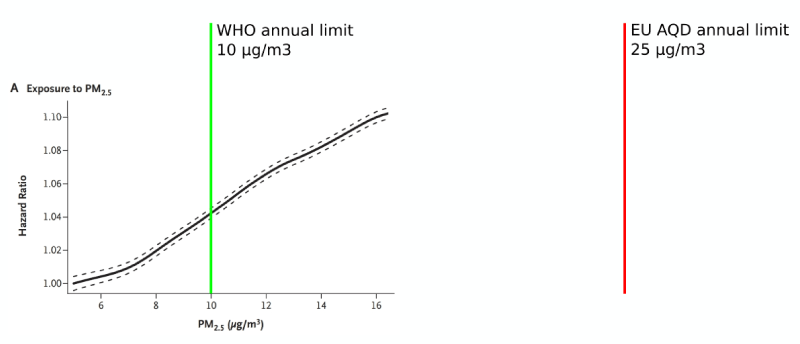Western Balkan countries are stuck in a loop of long, gloomy winters with extremely high air pollution. The number of times the air quality has exceeded the limit values over the last decade remains so high, that the very point of having those limit values is lost. In order to prevent episodes of air pollution that often reach values that are more than ten times above this limit, and to provide at least some level of protection for human health, additional urgent measures are required by the governments to supplement the long term strategies.
Davor Pehchevski, Balkan air pollution campaign coordinator | 5 February 2020

Relation between PM2.5 exposure and hazard ratio for death (Di et al. N Engl J Med 2017) and comparison with WHO recommended and EU legal annual limit values
Graph source
The Directive on ambient air quality and cleaner air for Europe (2008/50/EC) laid the foundations by which air quality in many European countries has been improving over the last decade. Air pollution was brought to safer levels, which in turn significantly improved the health of European citizens.
However, safer does not mean risk-free. The limits for even better health protection recommended by the World Health Organization (WHO) are considerably stricter than the ones given in the Air Quality Directive (AQD). But, WHO is also constantly reminding us that there are no safe levels of air pollution, a claim which is supported by a multitude of scientific research (see here and here).
Regardless of the fact that AQD limit values might not provide the best protection for human health, so far they have proven effective to push EU Member States to take action. When there is a risk that one or more limit or target values will be exceeded, Member States are required to draw up short-term action plans in order to reduce the risk or duration of such an exceedance. These plans are obligatory for levels of pollution from sulphur dioxide and nitrous oxides that are more toxic and are proven to have an immediate impact on health. For other pollutants, they are implemented where appropriate, which in practice means in most urban areas where there are many sources of pollution that can be targeted.
But, what happens when air pollution, specifically from dust particles (PM10 and PM2.5), is constant and levels are so high that these short-term action plans turn into annual plans? In Western Balkan countries it is currently impossible to keep air pollution levels within limit values. If the same practice is implemented as is in EU countries, the short-term action plans will be active almost every day throughout the winter months. While there is some prospect of improvement in the long term with proper implementation of the legislation already in place, something needs to be done now, too, at least to reduce the exceedances.
Several years ago, North Macedonia took a step in the right direction regarding this. In addition to the alert thresholds for sulphur dioxide and nitrous oxides, due to growing public pressure, the government introduced a similar threshold for PM10. The initial threshold, however, which activates emergency measures and recommendations if 24-hour PM10 values remain above 100 μg/m3 for seven consecutive days, proved pointless. The set limit value was quite ambitious considering the levels of pollution, but waiting for seven days (many of which had 24-hour values above 400 μg/m3) to trigger a response from the authorities offered little to no protection to the citizens.
This is why this threshold was changed in December 2017 to 24-hour PM10 values above 200 μg/m3 for two consecutive days. The new system also introduced an obligatory annual reduction of this threshold by 12,5 μg/m3. Although not perfect, this system proved more effective, and the annual reduction of the threshold provided a prospect for the reduction of pollution that the long term strategies should envision. The main setback of this system is that the emergency measures are canceled on the first day when the 24-hour value drops below the threshold, which as of December 2019 is set at 175 μg/m3, instead of extending them to the day when the legal limit of 50 μg/m3 is reached. It is not that 170 μg/m3 is less alarming than 175– it is still a long way from what needs to be achieved.
None of the other Western Balkan countries has an alert threshold for PM10; instead, they only have what the AQD prescribes– and in this case, that is the bare minimum. The levels of PM10 pollution in all of these countries in 2019 remained almost unchanged from previous years, and they are again making the headlines world-wide. At the same time, the new European Commission is working on the Green Deal that will very likely recommend bringing the EU’s limit values closer to the WHO ones. This will set a future standard for WB countries, all of which are aspiring EU members, that will be impossible to reach if action is not taken starting yesterday.
Adopting an alert threshold for PM10, and maybe even PM2.5, in combination with the right short-term measures and proper air quality monitoring, can have some impact in preventing episodes of extremely high pollution during winter months and will set the vision for the long-term improvement of air quality. It will also show some ambition and some consideration for the citizens’ health. Good practices should be embraced and continuously improved so that the region as a whole is moving forward.
Never miss an update
We expose the risks of international public finance and bring critical updates from the ground – straight to your inbox.
